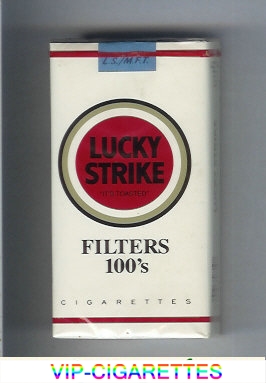

They were there to stand out among other brands, manufacturers even changed the design of the pack. So when World War II took place in Europe, and American soldiers went overseas, Lucky Strike cigarettes were right there. War has always been the best time of promotion of such "soft drugs" like alcohol and tobacco. Consumers immediately observed a new brand, but the real explosion was ahead. And the ability to seize the moment and make a bet on luck valued more than the in-depth knowledge and practical experience. One successful investment could bring millions of dollars. Marketers have relied on the sonorous name which fully complied with the spirit of the times, and moreover to the very American dream. And not just buy, but also earn money with the help of this brand. However, for a long time nothing special was observed concerning the brand and was just one of many brands in the United States.Įverything changed in 1905, when Lucky Strike decided to buy the American Tobacco Company. Initially, under the brand name Lucky Strike a cigarette there was produced and marketed a compressed tobacco to the population. There was invented an ambiguous name was for a mixture, lucky strike, usually translated as "successful hit," can also mean "lucky strike" prepared by protestors. The new economical owner did not throw the burnt tobacco, but slipped it to the usual blend, and suddenly received a new taste. In 1905 it was acquired by the American Tobacco Company (ATC), which later became British American Tobacco. It is one of the oldest cigarettes brands, dates back to 1871. Lucky cigarettes are a brand of American cigarettes. Counter-advertising should attempt to expose and undermine the needs satisfaction messages of cigarette advertising campaigns directed at women.Lucky Strike Cigarettes – consumers immediately observed a new brand This may explain why partial advertising bans are ineffective and comprehensive bans on all forms of tobacco marketing are effective. Conclusions: Psychosocial needs satisfaction can be communicated without reference to cigarettes or smoking. Cigarette brands for younger women stressed female camaraderie, self confidence, freedom, and independence cigarette brands for older women addressed needs for pleasure, relaxation, social acceptability, and escape from daily stresses. As women's needs change with age and over time, advertisements were developed to reflect the needs encountered at different stages in women's lives. Such positioning can be accomplished with advertising that downplays or excludes smoking imagery. Results: Tobacco industry market research attempted to identify the psychosocial needs of different groups of women, and cigarette advertising campaigns for brands that women smoke explicitly aimed to position cigarettes as capable of satisfying these needs. Methods: Analysis of internal tobacco industry documents and public advertising collections. Objective: To explore messages of psychosocial needs satisfaction in cigarette advertising targeting women and implications for tobacco control policy. It is concluded that the rapid replacement of images and slogans and the reliance on the ‘obshche-rossiiskaia ideia’ in advertising is symptomatic of an ongoing sense of psycho-cultural lack in relation to Russian national identity. Theories of cultural difference (Hostede and De Mooij) are utilized to support the view that generic marketing associated with globalization is particularly ineffective in the Russian context.

The different ways advertisers attempt to evoke both ironic and utopian nostalgia for a mythical Soviet or pre-revolutionary past are explored in detail. This article argues that this branding strategy, emphasised in advertising has been largely successful. Since the collapse of the Soviet Union a concerted effort has been made by all producers to Russianize their products. A number of ads are analysed, covering a period from the early post-Soviet period to the present in particular the development of the Yava brand from the early post-war period to the present is covered in detail. While some reference is made the television advertising of other goods such as beer, the focus is on tobacco, as many ads in this industry utilize the idea of nation.

This article sets out to examine how assumptions about national identity are projected in contemporary Russian advertising.


 0 kommentar(er)
0 kommentar(er)
